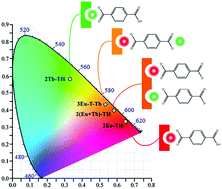Luminescent sequence-dependent materials through a step by step assembly of RE1–1,4-benzendicarboxylate–RE2 (REx = Y3+, Eu3+ and Tb3+) architectures on a silica surface†
Abstract
We present an approach toward sequence-dependent materials based on a stepwise assembly on a silica surface of rare earth cations (RE: Y3+, Eu3+ and Tb3+) and the 1,4-benzenedicarboxylate (terephthalate, T2−) ligand, organized in an ordered sequence RE1–T–RE2. The first RE was grafted to silica through a reaction of its N,N-dibutylcarbamato derivative, [RE1(O2CNBu2)3], with the surface silanols. The residual carbamato groups in the metal coordination sphere were then substituted by HT− through a reaction with H2T in pyridine. The Brønsted acidity of the pendant COOH groups was successively exploited for the anchorage of the second metal ion (RE1 = Eu, RE2 = Tb; RE1 = Y, RE2 = Tb). The choice of pyridine as the solvent, able to dissolve both H2T and the secondary product [NH2Bu2]2[T]·H2T, was crucial for achieving success with this method. The emission properties of the materials were modulated by modifying the order of the synthetic steps. Metal complexes and materials were characterized by IR, EDX, ICP and photoluminescence. We used Tb3+ to Eu3+ energy transfer (ET) to study the RE3+ spatial distribution and intermetal distances to prove the formation of a RE1–T–RE2 sequence. Photoluminescence was used as a multi-tool technique to characterize the functional properties of the materials and to obtain structural information supporting the sequence growth.



 Please wait while we load your content...
Please wait while we load your content...